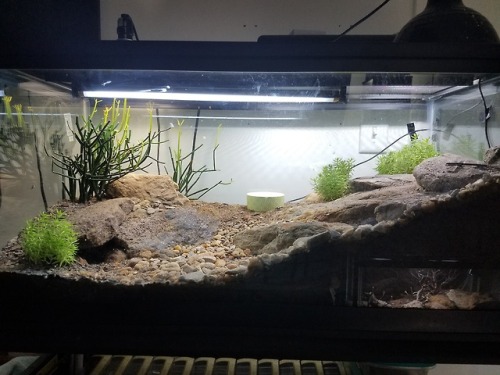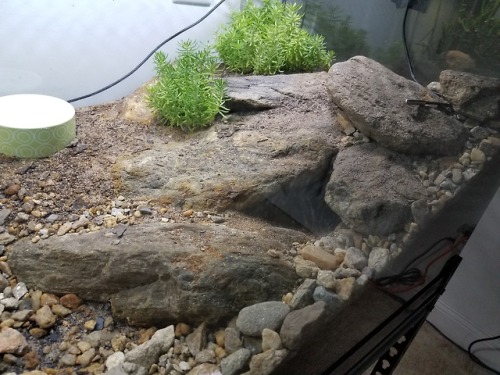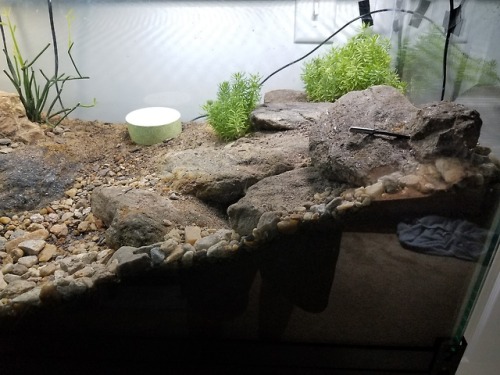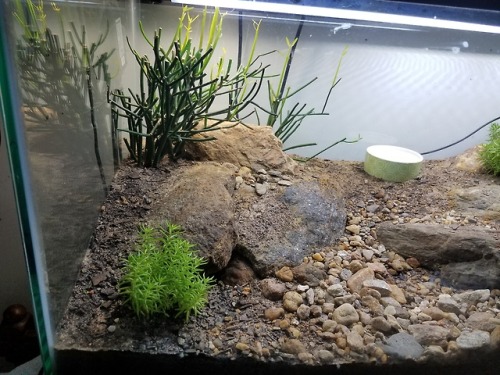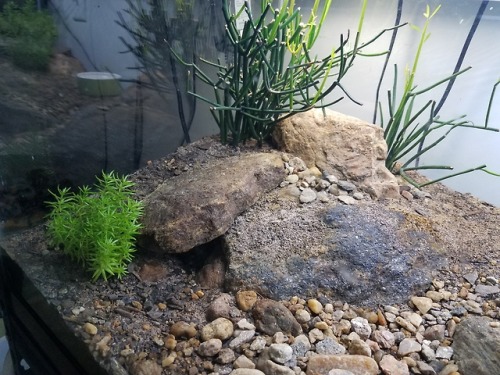manticorareptiles:So along with Crested Geckos I also keep several other species of reptile. This is
manticorareptiles:So along with Crested Geckos I also keep several other species of reptile. This is the bioactive enclosure for my male Leopard Gecko, Aurelio. The enclosure is a 40 breeder that originally belonged to my female Leopard Gecko, Bonita. But after she passed I revamped it and gave it to Aurelio. The tank took a lot of work to set up and is the result of years of experimenting with bioactive with Leopard Geckos. The substrate is a mixture of Excavator clay, Quikrete All Purpose Sand, and a generic organic potting mix from my local hardware store. I do 50% soil, 30% sand, and 20% clay. After they were all thoroughly mixed I sieved the substrate to remove large pieces of stone and wood. When setting up the enclosure I took all the sieved wood and stone and used it to line the very bottom of the enclosure. I then added a ton of temperate springtails and some baker’s yeast to encourage mold growth. That mold becomes a good food source for springtails and bacteria that will help to keep the tank clean. The next few steps are hard to explain in depth without pics, so I’ll keep things short and simple. Basically I added my substrate mix next, I added a black plastic hide on the right, and a half log hide on the left. Both are buried under substrate and stones so they’re basically invisible. I furnished the enclosure with stones taken from a local state park, that were then sanitized, and a couple types of plants. The plants I chose were Euphorbia tirucalli and Sedum reflexum “yellow bouquet”. The plants are doing well and have been growing nicely. For a cleanup crew I have temperate springtails, tropical springtails, Armadillidium vulgare isopods, dwarf white isopods, terrestrial nematodes, fungus gnats (for some people these are a pest but as maggots they can be a great cleanup crew in the soil), dubia roaches, buffalo worms/beetles, mealworms/beetles, and lots of various bacteria and fungi that are naturally present in the soil. The enclosure is only a month or so old but already my Leopard Gecko’s waste is getting broken down after only a day or so. Which is a GREAT sign!The tank is lit with 3 grow bulbs, as well as a 24″ T5HO 10.0 UVB bulb. I strongly believe ALL reptiles should have access to UVB so despite some articles out there, I chose to give my Leopard Gecko UVB. For heating I use a 150w CHE on a thermostat. The CHE is in a wide-domed lamp allowing for max heat distribution. This gives my gecko the opportunity to thermo-regulate as he has access to basking areas ranging from 78*F up to 94*F. The ambient temp in the cage is 74*F during the day with a 2*F-4*F drop at night. As said before, Aurelio only has two hides. One cool, and one warm hide. However, due to the fact that the cage is bioactive and is misted weekly the hides are BOTH humid hides with humidity ranging from 60%-90%, something VERY important for a Leopard Gecko’s health as despite common knowledge, Leopard Gecko’s naturally seek out more humid areas and burrows in the wild. Exposing them to consistently dry conditions in captivity can be very detrimental for their health.I’ve seen Leopard Geckos in some seriously inadequate enclosures so when I redid this tank to give it to Aurelio, I chose to give him the very best life I can. And since upgrading him, I’ve noticed him basking more in the UVB, he eats better, his color is better, and he’s noticeably more active. Keeping your animals in tubs or bare bottoms tanks is NOT natural and here at Manticora Reptiles I chose to give my animals the very best life I can in a bioactive setup. -- source link
Tumblr Blog : manticorareptiles.tumblr.com
